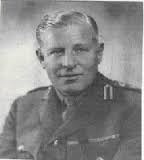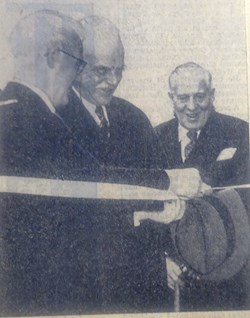
Two Colonels
* * *
Sir Francis Henry Douglas Charlton Whitmore was born at Gumley Hall in Leicestershire on 20th April 1872. In 1890 the family moved to Orsett Hall, an almost-dilapidated mansion on an 8,500 acre estate which fell to the young Francis to manage after his father lost interest upon his mother's death in 1892.
Eton educated, Sir Francis' distinguished military career began in 1892 when he joined the Essex Volunteer Artillery whose headquarters were based in Southend but with a battery at Grays. This unit became The Essex Yeomanry in 1908 under the command of Lieutenant Colonel Edward Deacon with, by then, Major Whitmore as Second-in-Command.
In France in 1915 at the second battle of Ypres, Sir Francis was severely wounded but returned to take command and engage in many battles. In April 1918, he was given command of the 10th Royal Hussars which he led with distinction through to the defeat of Germany. Sir Francis was awarded the DSO, TD and CMG for his gallantry, and was mentioned in dispatches on four occasions. Well-liked as an officer, he was a stickler for discipline and expected the highest standards of dress and appearance.

Sir Francis Whitmore
After WW1 he continued to run the Orsett estate and his boundless energy enabled him to undertake numerous military posts – Chairman of the Territorial Army Association (1929-1936), a member of the Territorial Army Advisory Committee to the War Office (1939-1945), President of the National Service Committee for Essex (1939-1945), Commander of the Essex Home Guard (1940) and Honorary Colonel of three Essex Yeomanry Regiments during and after World War Two. One of Essex’s most decorated military officers, he served the county with much pride for over 50 years.
And he was highly-active in civil public service - a JP (1899), Deputy Lieutenant and Lord Lieutenant of Essex (1936-1958), a CB (1935), KCB (1941) culminating in his being created a baronet (1954). As Lord of various manors including Stifford, Corringham and Orsett, he engaged in a good many activities throughout Essex – as president, chairman or benefactor of numerous societies, sports clubs, and organisations in many aspects of community life throughout the county. Sir Francis was held in high regard and much affection. He died on 12th June, 1962 and was buried with full military honours at St Giles & All Saints Church in Orsett.
Sir Francis' interest in cricket was evidenced by his appointment as president of Essex County Cricket Club in 1923. In 1932 he sold 64 acres of land at Blackshots Playing Fields in Grays to Thurrock Council. It was known as the Recreation Ground until 1935 when it became the King George V Memorial Playing Fields***. He also gifted Orsett Recreation Ground to Orsett CC in the 1930s but it was transferred to Thurrock Council a couple of years' later when Orsett found they were unable to maintain it. And in 1960, Sir Francis kindly gifted land, since now known as North Stifford Village Green, to Thurrock Council for use by the local community.
Colonel John Dudley Sherwood of Stifford Lodge (now the Stifford Hall Hotel, an elegant 18th century Georgian mansion) was also a cricket enthusiast and he kindly defrayed the cost of a new village hall and fittings, ' . . .to double as a sports pavilion for sportsmen using the adjoining field'*. In 1954, Sherwood Paints (Colonel Sherwood's successful paint company) played against North Stifford CC on the small area of land opposite Coppid Hall (at the East end of the High Road next to St Mary's Church), losing by 6 wickets: unfortunately, the Colonel was dismissed for a 'duck'.

Colonel John Sherwood
Colonel Sherwood adopted the role of village squire and was generous towards villagers including invitations to garden parties at Stifford Lodge. He enjoyed the winter months at his home on the west coast of Barbados where, coincidentally, Belhus Cricket Club later arranged tours in 1976, 1991 and 2018. He worshipped at St James Parish Church in Holetown where a brass plaque
was erected to mark the Colonel's generous contribution to the cost of construction of a porch on the north side of the the churchThe Colonel died in Barbados on 26th February, 1966. Although he was buried at Brookwood Military Cemetery in Surrey near his parents home. A memorial service was held at St Mary's Church in North Stifford where he served as a churchwarden. The road, Sherwood, which adjoins the Eastern boundary of the cricket ground on the Village Green, was deservedly named in his memory.

Opening of North Stifford Village Hall by
Sir Francis Whitmore (centre) - May 1960
Along with many others (including the now defunct local club, North Stifford CC) Belhus Cricket Club is indebted to the Two Colonels. These two generous benefactors could never have imagined that their contributions would result in cricket being played on the Village Green for more than half a century and, hopefully, long into the future.
* * *
* Thurrock Gazette 27th May 1960
** The Stifford Saga. Doreen Dean and Pamela Studd 1980
*** Thurrock 100 Stories. Ali Pretty Kinetika People 2016
* * *
Denis Reed, December 2016